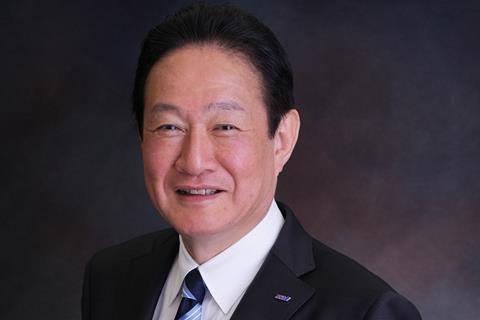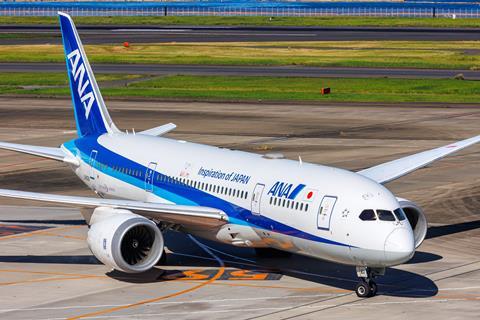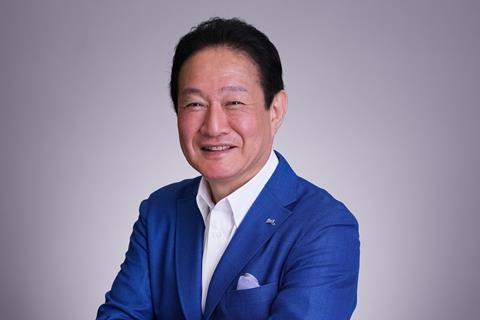ANA chief executive Shinichi Inoue can draw on experience from a long career with the group as he works to meet high customer expectations for its expanding product offering
Baseball enjoys a large following in Japan, and it is therefore no surprise that the leader of the country’s largest airline would draw reference to it.
Shinichi Inoue is the president and chief executive of All Nippon Airways (ANA). Speaking to Airline Business in Tokyo, Inoue says that the airline has set its sights on becoming the “Shohei Ohtani” of the airline sector, a reference to the Japanese baseball player who is arguably the top in his field.

A curious pause from this reporter emerges, and Inoue ventures: “He is a very famous baseball player in Japan… and maybe the world too. Do you know him?”
Ohtani might be an unfamiliar name to those not following baseball (like this reporter), but the ANA brand arguably enjoys far wider recognition.
Still, ANA, says Inoue, must be like Ohtani – the “number one airline in the world… in a very competitive environment”.
Like the Los Angeles Dodgers player, the airline is well-decorated: it has clinched several industry accolades, including for its on-time performance.
Hoping to continue the home-run streak is Inoue, a 34-year veteran of the airline who was promoted to the top job in 2022. Inoue joined ANA in 1990 in its personnel department, moving up the ranks in its sales and planning department in the early 2000s.
He was in 2011 tasked with setting up a low-cost business for the ANA group, culminating in the launch of Peach Aviation, which he led for nearly a decade before moving back to the mainline carrier.
Inoue took the helm of the Star Alliance carrier in April 2022, at a point in time where Japan remained largely closed off to international travellers, but most of the world was already opening up. Months later, Japan would ease most of its border restrictions, ushering in an influx of foreign visitors to the country.
The reopening of borders was a boost for ANA’s fortunes, as inbound passenger numbers continued to recover.
For the nine months to 31 December, ANA’s parent more than doubled its operating profit to Y210 billion ($1.4 billion) – the group’s highest nine-month profit on record – as revenues continued to climb.
It attributes the rise to strong demand from inbound and leisure travellers, which offset an increase in operating costs.
“We are focused on competition in the global market – not just in Japan”
Inoue tells Airline Business that international traffic is now at around 70% of pre-pandemic levels, but that revenues have already recovered beyond that – a positive sign for the airline as it reports record profits. Separately, domestic capacity has now recovered to around 90%.
Inoue is also keen to tap opportunities from the “shifting trend” of more individual travellers as well as “more affluent travellers” coming into the country. He notes that while the number of inbound visitors to Japan increased by about 10% from pre-pandemic levels, the spending per person increased by about 34% on average.
Now, Inoue is overseeing a different chapter in the carrier: at the time of Airline Business’s interview, medium-haul low-cost sister unit AirJapan had just launched operations.
The launch of AirJapan helps the group fill a gap in its network and revenue source, and is a key part of its strategy for “attracting future demand”.
AirJapan, operating as a hybrid carrier, will “capture inbound demand from major cities in Southeast Asia”, says Inoue.
“We have [the] competitive advantage by leveraging our low-cost experience [and] high efficiency… with experience operating ANA flights,” he says.
BRIDGING THE SKIES
AirJapan, which started operations in February flying to Bangkok, operates Boeing 787s configured in an all-economy layout. It also flies to Seoul and will be launching flights to Singapore in April.
In opening remarks for the airline’s inflight magazine Tsubasa Global Wings, Inoue describes how the launch of AirJapan means there is now a “tricolour bridge in the sky” connecting Japan with the rest of Asia.
“Through people, products and services, the three companies will continue to provide colour throughout Asia,” he writes, referencing the operations of ANA group’s three different airline units.
Indeed, Inoue is bullish about the opportunities present for the three-brand group, talking up the need to target “different market demands”.
He also brushes off any concern about an overlap of operations – especially between AirJapan and ANA – stressing again that each carrier has its specific target market.
“I’m not concerned about the network overlap,” Inoue says. “The purpose is to leverage the strengths of ANA, Peach and AirJapan to enhance customer options and profitability, by targeting different market demands.”

He calls ANA the “Top Gun carrier” – another pop culture reference – that “will continue to strengthen its global network and offer ultimate service”.
Peach, meanwhile, targets “leisure demand for short-haul routes”, while AirJapan targets medium-haul demand from Southeast Asia and Oceania.
“The strategic approach of the three brands will complement each other, offering customers diverse options based on their preferences. That’s the unique strength of the ANA group,” adds Inoue.
He declines to be drawn into comparison with compatriot Japan Airlines, which has a similar business model with one full-service carrier brand, a medium-haul hybrid carrier, as well as a low-cost brand.
“We serve our customers from all over the world, and we are focused on competition in the global market – not just in Japan,” he adds.
Inoue is very aware that – like a pro-baseball player – the ANA brand is closely scrutinised by the public and the competition alike. He expects competition in the near-term to intensify, given the consistently strong travel demand to Japan.
“Other challenges include ongoing geopolitical risks and market competition, as well as managing our operating costs and a shortage in the workforce,” says Inoue.
OUTBOUND DEMAND
Another challenge Inoue has flagged before is how the weaker Japanese yen has led to an imbalance in the recovery, with inbound demand far exceeding outbound.
More than a year into Japan’s border reopening, there is some progress made. He notes – but does not elaborate – that outbound business travel demand is “performing well”, with strong yields.
He also acknowledges that it is a longer trek for outbound leisure demand to recover.
“[Leisure] travel sentiment is progressing positively, especially during the [New Year’s] holiday season as we carried record passenger numbers to Hawaii. I am sure that people have the desire to travel, so we are very positive,” he says.
At the IATA AGM in 2023, Inoue remarked to the media that the airline hoped to “turn winter into spring and into summer”, in a reference to the imbalance in inbound and outbound demand.
Asked again about those remarks at the latest interview, Inoue lets out a hearty chuckle. With a wave of the hand, he says: “Spring is here, spring is already here. No more winter!”
“I am sure that people have the desire to travel, so we are very positive”
For instance, the airline is focused on restoring and expanding its European network this year, adding cities like Istanbul and Stockholm. This comes despite operational challenges posed by the closure of Russian airspace to many carriers, including Japanese airlines – another positive sign that demand is returning.
The airline is also poised to welcome new aircraft types – Boeing 737 Max 8s and 777-9s – from 2025. It is also due to take delivery of its first 787-10 configured for domestic operations, using the type to replace 777s that are being phased out.
As the airline plots its future growth, Inoue is quick to remind how ANA’s initial beginnings were far humbler: a “start-up with two helicopters” that eventually grew to become the country’s largest carrier.
This echoes Inoue’s earlier sentiments – expressed in another Tsubasa Global Wings column in October 2022 – about the airline’s “DNA”. He wrote then: “[Our] predecessors actually created what would be called a ‘venture company’ today. ANA’s origins were in distinct ventures, or in other words, challenges.”
Inoue brings with him his own start-up company experience, having helped set up Peach more than a decade ago. He views his stint with fondness, even as he admits that it was “a big challenge for myself” at the start.
“But I came to know some special knowledge… and gained some experience from the [low-cost] business, and I think that would benefit the business model for ANA,” he says.

One important lesson Inoue says he learnt from the experience was related to digitalisation, which at the time he helmed Peach was gaining popularity among other low-cost operators.
“Digitalisation [of existing services] can help increase productivity. The LCC model is a model of high productivity: less people, more productivity… [and] more revenue,” he says.
While the Covid-19 pandemic has gone some way towards accelerating the need for digitalisation, the airline is still working to “actively respond” to growing digital requirements.
“After Covid, we see customers wanting a seamless [digital] experience from check-in, to boarding, with no requirement for human services or contact,” says Inoue.
He also believes in engaging ANA’s employees, noting that employee satisfaction equates to better customer engagement.
“I have to take care of our employees… in order to develop our business,” he says.
Asked what the secret to ANA’s success over the course of its history is, Inoue mulls for a brief moment, before offering a simple tip.
“After the pandemic, we are now stepping into [an] unforeseen era all over the world. In such… tough circumstances, all we have to do first is to listen to what the customer is saying and create a new value… based on the customer insights,” he says.
Inoue adds the airline “must work hard to adapt to customer preferences”, noting those preferences are changing very quickly, especially in a post-Covid operating environment.
“When people look at ANA they expect us to be one of the leading carriers of the world,” he says.








